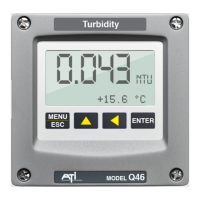3
O&M Manual
Rev-E (2/16)
Part 1 – Profibus Description
1.1 General
Q46 Analyzers are available with four digital communication options. Profibus-DP, Modbus-RTU,
Modbus TCP/IP or Ethernet-IP. This manual applies only to instruments supplied with the
Profibus-DP communication option.
1.2 Profibus Communication
Profibus is a manufacturer-independent communication standard, based on EN 510170, that is
widely found in applications involving factory automation, building systems controls, and process
monitoring. It is a fieldbus standard that allows devices designated as “masters” and “slaves” to
communicate with each other and perform independent or combined tasks. Master devices on
the network are the devices that maintain control over the entire network, while slaves are
devices that report limited information or perhaps control a limited function. Control of the slaves
occurs in a cyclic manner. There are three main forms of Profibus: Profibus-DP, Profibus-PA,
and Profibus-FMS.
The Q46 is currently a Profibus-DP slave device. Profibus-DP is a high speed data exchange,
and is the more generic form of the protocol – including a wide variety of instrumentation and
devices.
1.3 Profibus DP Transmission Details
The Profibus communication link consist or two basic parts: the actual communication
hardware/bus, and the software scheme that controls what/how information is sent.
The Profibus hardware operates over a proven RS-485 differential network. A very special
shielded, twisted 2 conductor, copper cable is used as the bus connection wire. The bus
structure allows addition or removal of operating points at any time, without disturbing existing
connections. Data transmission speeds of 9.5k to 12M are user selectable, and are generally set
based on the environment and application requirements. Each segment must be terminated by
an active bus terminating resistor. For the Q46, this termination resistor must be included in the
DB9 adapter that connects to the side of the enclosure. On a segment, both bus terminators
must always be powered to ensure fault-free operation. Up to 125 devices can be installed on a
network.
The Profibus software is a standardized software protocol to which all Profibus users much
comply. Profibus DP is typically coded to the level of the software protocol to which the device
complies; DPV0, DPV1, or DPV2. DPV0 is the basic form, DPV1 includes some alarm reporting,
and DPV2 allows an advanced form of slave-to-slave communication. The Q46 is DPV0, as its
alarm functions are coded into its cyclic data. A unique text file, called a GSD file, is used to set
the specific information at the master as to what information will be sent over the network from a
specific device. This GSD file must be integrated into the master controller on the bus during
commissioning of the Q46 on the network.

